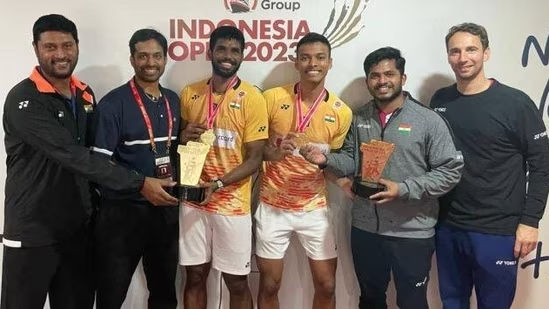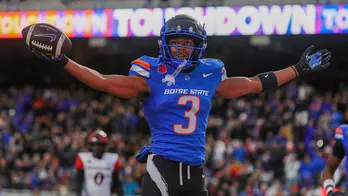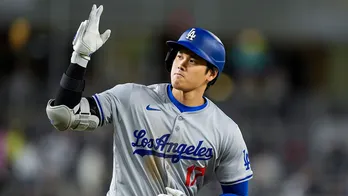'Most of our opponents know it is not fun to play us'
Though Mathias Boe never won the Indonesia Open despite reaching two finals in his long and illustrious career, he still got to hold the prestigious trophy. Satwiksairaj Rankireddy and Chirag Shetty, wards of the 42-year-old Dane, laid claim to the celebrated title to become the first Indians to win a Super 1000 tournament on Sunday.

The world No 3 Indian pair has become a force to reckon with in men’s doubles badminton, winning one accolade after another. Though they won titles earlier too, this current run of form began after the two-time All England champion took charge of the Indian doubles shuttlers in April 2022.
The force behind the formidable Satwik and Chirag, Boe discussed the rise of his proteges, the challenges they now face after becoming so consistent, peaking in major events and how they celebrated Sunday evening following the win in Jakarta. Excerpts:
How did you celebrate winning the Indonesia Open?
We all had a good dinner together at the hotel we were staying at. The support staff, the boys, (chief national coach Pullela) Gopichand, and me. We had a nice, good, and quiet dinner. Nothing crazy but it was a good evening. There was a big buffet with Indian, Indonesian, and continental sections. Satwik sticks to the Indian kitchen if he can. So, he had naan and some Indian food, Chirag went to the Sushi counter. I was a little bit all over.
You twice reached the finals but never won the Indonesia Open. How was the feeling when your own pupils won it?
I am a bit jealous (laughs). Jokes aside, I am really happy for the boys. They have done extremely well. To win men’s doubles at Indonesia Open is not easy at all. Right now, there are five Indonesian pairs in the top 16 who get a boost when they play at home. Jan O Jorgensen was one of the first Danish players to win Indonesia Open in 2014. It really shows how difficult it is to win that tournament when players from Denmark have never been able to win it. It was the first Super 1000 tournament not just for the boys but for any Indian. So, it is a huge result.
Satwik and Chirag had been doing well but they have gone on a tournament-winning spree since you rejoined the setup last year. What changes did you introduce?
I have been pretty clear in changing some tactical things in their game. It is obvious what they are good at and what they can become even stronger at. When I was a player, I was tactically a bit better than my opponents. So that was my forte as a player. Some of these things I have been able to pass on to the boys and in having a clear strategy when we go and do an analysis of our performance. But there is no secret to hard work. I have tried to push them, I have tried to make them aware of the need to practice as hard as possible each day. Just be hungry to practice more and become better, maybe also a little bit more discipline and make them think more about badminton than they are doing. Instead of just coming in and getting instructions on what they need to do, I am trying to tell them that it is a 24x7 job. The last thing you need to think about when you go to bed is what you want to improve. The morning after when you sit in the car and return from practice think about what you could do better. So, it is about thinking these things and if they don’t have these thoughts themselves then they will not improve enough. So that is what I keep telling them. I can only guide and highlight what is important, it is they who will make themselves good badminton players. That is the key thing I try and pose to the players.
Now that they have become so consistent, what challenges hereon?
I don’t think much will change. Most of our opponents know it is not fun to play us if we have a good day. I don’t think this title or this ranking will change anything. I know it is a benchmark for them to be ranked No 3 in the world. For me, it doesn’t really matter if they are 3, 5, 6, or whatever. It is about being good enough to win. Right now, if you are No 3 in men’s singles you probably won’t win many titles because you have Viktor Axelsen who is No 1 and just much better than the rest. In men's doubles, it is not like that, luckily for us. We are not ranked No 1 but there are a lot of contenders who can win. What is important for me is that we stay that way. Winning all titles is unrealistic but at least if we win titles every once in a while and are in the race for bigger championships, that is most important. I do understand the boys are of course happy being ranked No 3 in the world for the first time. For me, it is not a big thing. When they become No 1 in the world, we can celebrate like we celebrate any tournament victory.
What are their current weaknesses that you would like to convert into strengths?
That's the good thing about being an athlete. There are always things you can improve. We know what that is and we will keep working on that. There is no perfect athlete in this world. It doesn’t exist. We will try and see if we can become as perfect as we can. What it is we will keep to ourselves.
Satwik and Chirag are naturally an attacking pair but they displayed brilliant defensive skills throughout the week in Indonesia, turning their defence into offence.
They can't just get on the attack all the time. The opponents also know when they lift high to us then we have a really strong offence. It is really difficult to score points if they are bad with the lift so obviously, they will try and attack. Therefore we need to be able to play the defence also. We can’t just block all shuttles, we also need to lift them and then counter them from the defence. Shuttles were a bit slower in Jakarta this year. That gave us a chance. You have to play the defence because if you play everything to the net then it is too easy and predictable for the opponent. They played a really solid and consistent defence and we got that counterattack that is required. So we don’t only play an offensive game but are also able to lift and counter it from the defence. That was definitely part of the tactics all the way through.
The duo seems to be hitting its peak but how do you maintain it keeping in mind the upcoming World Championships, Asian Games, and the Olympics?
The boys are well aware of what is at stake for the next year. We are going to keep pushing and practicing hard. If they relax too much and enjoy then I am there to remind them to keep pushing. I don’t think it is an issue with them. They know what is at stake and seem hungry and really determined to do well. Now they understand the importance of the need to keep pushing, being hungry, and working hard each and every day. I am not so worried about that. But in case that will be an issue I will push them to stay focussed.
Other pairs like MR Arjun and Dhruv Kapila have also improved drastically and are making the cut for top events.
Now Indian men’s doubles is on the map. We have Dhruv-Arjun and Krishna (Prasad Garaga)-Vishnuvardhan (Goud Panjala) also in the top 40. Dhruv and Arjun have really challenged some of the best and have also had huge results like reaching quarter-finals of World Championships last year. They are on the rise. They played extremely well in Indonesia and almost beat the second-best Malaysian pair. It gives them a boost seeing Satwik and Chirag making things possible. I am quite sure they are willing to push to become as good as them if not better. It is really positive that we now have some good top pairs and some really good juniors also playing well. Overall it is very positive. There's no secret to hard work and the boys know that.
But how do you deal with them when they suffer such close losses?
We evaluate after each and every match and see if we can find out what the reason is. Sometimes we don’t play well and lose points, sometimes we get off to a bad start. There can be a lot of reasons. We try and see if there is a pattern when we are losing and then try and talk about it, try and do something. We don’t continue doing the same.
What do you make of the women’s doubles pairing of Treesa Jolly and Gayatri Gopichand who have also seen a dramatic rise?
Gayatri and Treesa they have done really well, reaching the (All England) semi-final this year. After that they have been down a little bit, not playing at their best but there were some positive signs in Indonesia. They played really well even though they lost to a Japanese pair in a match they could have won. But these girls are still young, 19 and 20. They need to mature a little bit more, need to be a little consistent. They have a little bit of the X-factor. Gayatri is extremely skillful in front of the court and Treesa has a huge smash and both of them are really good at changing pace.
When they become a little insecure, they are not so consistent as many of the other top pairs and that is what makes the difference. They were on a roll against the Japanese pair and actually outplayed them but with the Japanese, it is just like a smooth engine that runs at the same pace all the way through. When we don’t play well, we let them score too many points. We need to work on their consistency and for them to be more stable and not drop the level so much when they don’t play well. But I am positive. It takes a lot of hours to turn into a good badminton player. They work hard and I am confident. We need to give them a few years.
Your thoughts on the seasoned Ashwini Ponnappa now partnering with the up-and-coming Tanisha Crasto? They won an International Challenge in France on Sunday.
I am really happy that they played together. It is important that we now have two women’s doubles (pairs) that can compete, practice and push each other. That is how you create this ecosystem of competitive spirit in practice. They are a good pair who obviously now need to improve their rankings so that they can get into these bigger tournaments but they are also better than playing these International Challenges. I am not at all surprised that they won. They can play in some of the bigger tournaments as soon as their ranking is good enough. Ashwini is quite experienced but still works really hard every day and has a lot of passion for badminton. Tanisha is a huge talent like Gayatri and Treesa. We have three extremely skilled young girls doubles players in India who have a chance of making it to the top.
How much of a role does a coach play in partnering players?
I am probably not the right person to answer that. I feel it is a little bit unstructured and mostly up to the players. I don't know how much the coaches or associations have a say. The ranking has also changed now so it is not easy to change partners. If you change partners, then it is a big mess with the ranking. That is what you’re seeing with Tanisha and Ashwini. They should be able to enter maybe not a Super 1000 tournament but at least the 300 and 500 because of their ranking. As they are a new pair, they can’t get entries into these tournaments. This is one big mess that makes swapping partners even more complex.
You’ve been coming to India for years. But how has your time been in India as a coach?
If I say it is easy, I would lie. It is very different from how we (Danes) do things. It can be optimised a lot; everything from travel to camps to all these things when we go to tournaments. It is quite a challenge but when we are in the academy and it is just the coaches and players then everything works really well. It is a different way of structuring things and it doesn’t make it always easier. But we try and manage and make the most of it. Sadly, badminton is still not a commercial sport. In all countries, there are different challenges. It was the same in Denmark. There were a lot of things that could be improved but couldn’t for one or the other reason. It is just a universal thing with badminton. When it is not a commercial sport then there are a lot of obstacles. But we try and make the most of it. It is just about being positive, it is about looking forward and really trying and change things that are possible on a daily basis. Mine and Gopi’s relationship is really good so we get these things adjusted the best way we can and try and make the best circumstances for all the players.
Disclaimer: The copyright of this article belongs to the original author. Reposting this article is solely for the purpose of information dissemination and does not constitute any investment advice. If there is any infringement, please contact us immediately. We will make corrections or deletions as necessary. Thank you.







